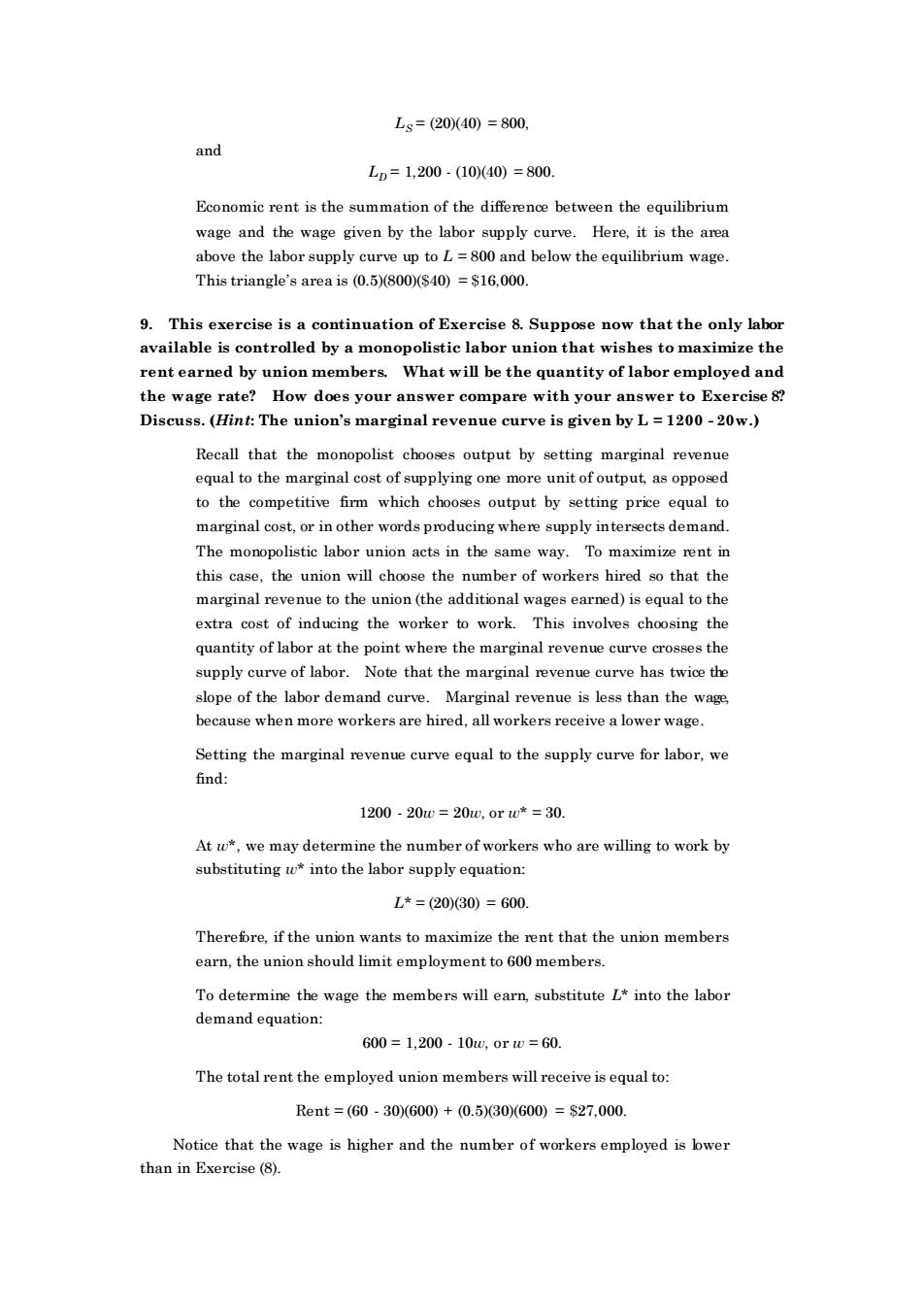正在加载图片...

Ls=(20(40)=800. and L=1,200-(10(40)=800. Economic rent is the summation of the difference between the equilibrium wage and the wage given by the labor supply curve.Here,it is the area above the labor supply curve up toL=800 and below the equilibrium wage. This triangle's area is(0.5)(800)($40)=$16.000. 9.This exercise is a continuation of Exercise 8.Suppose now that the only labor available is controlled by a monopolistic labor union that wishes to maximize the rentearned by union members.What will be the quantity of labor employed and the wage r ate? How does your answer compare with your answer to Ex ercise 8 Discuss.(Hint:The union's marginal revenue curve is given by L=1200-20w.) Recall that the monopolist chooses output by setting marginal revenue equal to the marginal cost of supplying one more unit of output,as opposed to the competitive firm which chooses output by setting price equal to marginal cos or in other words producing where supply. The monopolistic acts in the same way. To maximize rent in this case.the union will choose the number of workers hired so that th marginal revenue to the union(the additional wages earned)is equal to the extra cost of inducing the worker to work.This involves choosing the quantity of labor at the point where the marginal revenue curve crosses the supply curve of labor.Note that the argin al revenue urve has twie th slope of the labor demand curve.Marginal revenue is less than the wage because when more workers are hired,all workers receive a lower wage. Setting the marginal revenue curve equal to the supply curve for labor,we find: 1200-20w=20e,0ru*=30. At w*,we may determine the number of workers who are willing to work by substituting into the labor supply equation: L*=(20)(30)=600 Therefre,if theunion wants tomaximize the ent that the unon members earn,the unionshould limit employment To determine the wage the members will earn,substitute into the labor demand equation: 600=1.200.10,ore=60. The total rent the employed union members will receive is equal to: Rent=(60-30600)+(0.5)30)(600)=s27,000. Notice that the wage is higher and the number of workers employed is bwer than in Exercise(⑧). LS = (20)(40) = 800, and LD = 1,200 - (10)(40) = 800. Economic rent is the summation of the difference between the equilibrium wage and the wage given by the labor supply curve. Here, it is the area above the labor supply curve up to L = 800 and below the equilibrium wage. This triangle’s area is (0.5)(800)($40) = $16,000. 9. This exercise is a continuation of Exercise 8. Suppose now that the only labor available is controlled by a monopolistic labor union that wishes to maximize the rent earned by union members. What will be the quantity of labor employed and the wage rate? How does your answer compare with your answer to Exercise 8? Discuss. (Hint: The union’s marginal revenue curve is given by L = 1200 - 20w.) Recall that the monopolist chooses output by setting marginal revenue equal to the marginal cost of supplying one more unit of output, as opposed to the competitive firm which chooses output by setting price equal to marginal cost, or in other words producing where supply intersects demand. The monopolistic labor union acts in the same way. To maximize rent in this case, the union will choose the number of workers hired so that the marginal revenue to the union (the additional wages earned) is equal to the extra cost of inducing the worker to work. This involves choosing the quantity of labor at the point where the marginal revenue curve crosses the supply curve of labor. Note that the marginal revenue curve has twice the slope of the labor demand curve. Marginal revenue is less than the wage, because when more workers are hired, all workers receive a lower wage. Setting the marginal revenue curve equal to the supply curve for labor, we find: 1200 - 20w = 20w, or w* = 30. At w*, we may determine the number of workers who are willing to work by substituting w* into the labor supply equation: L* = (20)(30) = 600. Therefore, if the union wants to maximize the rent that the union members earn, the union should limit employment to 600 members. To determine the wage the members will earn, substitute L* into the labor demand equation: 600 = 1,200 - 10w, or w = 60. The total rent the employed union members will receive is equal to: Rent = (60 - 30)(600) + (0.5)(30)(600) = $27,000. Notice that the wage is higher and the number of workers employed is lower than in Exercise (8)